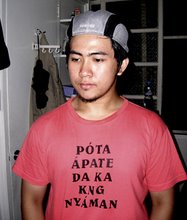These were our five-fold advocacies:
Broadcasting. To place a mark in the ongoing history of Philippine broadcasting by introducing the first ever regionally-produced Kapampangan TV series and, in so doing, make Kapampangans prouder of their ethnicity
Amanung Sisuan. To further intellectualize the Kapampangan language by showing to people, especially the urban youth, that it is an equally competent language appropriate for use in other forms of TV shows.
Kalalangan. To further showcase and develop what the Kapampangans can offer in fields linked with TV series production—direction, acting, production design, music, and scriptwriting for television. (A lot of Kapampangans boast of their seemingly inborn artistry; but why can't we showcase these wonderful gifts? Because we have not a lot of venues.)
Kultura at Turismu. To subtly promote Kapampangan culture and the province itself by incorporating local customs and traditions, by featuring places and other popular landmarks, and by showing cultural products like Kapampangan dishes and crafts in the episodes. (Read: Kimchi was made more popular by the Korean entertainment wave).
Pambansa at Pang-Yatu. To make an attempt in showing to the rest of the Philippines and of the world, if reachable, that Kapampangan culture—both traditional and pop—is a potential player in the rising culture industry.
Our concept:
Like other Philippine regional communities, Kapampangans possess a rich and colorful collection of folklore. We, at some point in our lives, especially during our younger years, have heard of stories about the magkukutud, the Kapampangan equivalent of the Tagalog manananggal; the kapri, tree-dwelling ogre-like elementals; the patianak, miniature elementals that dwell on earth mounds; the maglalage, the untamed and unsatisfied ghosts of the deceased; and other supernatural characters.
Also, without most modern Kapampangans knowing, we have a wide range of healers and sorcerers apart from the popular magkukulam and mambabarang, each with their own functions, methods, and specialties. There is the magkukusim, who can project his soul from his body to bewitch people across distances. There is the katulunan, who can directly contact the spirits and elementals. We also have the uple (illusion makers), manlalasun (venom experts), ukluban (equivalent of the Tagalog hukluban), mamalian (spirit channels), manggagawe (herbal experts), and many other strange, magical characters that continuously add color to our local culture, but are sadly being forgotten, being replaced by foreign monsters like the Bogeyman, vampires, and mummies.

In Kalam, we wish to propagate once more in detail our local folklore, which, although in the brink of dying from the minds of the people, still rings a bell for people who spent their childhood listening to the rural legends of Apu.
However, instead of portraying these magical characters in their conventional barrio setting, we will be portraying them in the modern, urban world, dissolving the gap between science and superstition, technology and magic, the contemporary and folklore, and the traditional and the modern.

Imagine mangkukulam, magbantala, and mangguguna living with us in the city as seemingly normal people who dress up like us, listen to the same songs we patronize, watch the latest rock concerts, occupy seats in the government, attend in well-known schools in the province, fall in love with the heartthrob next door, and occupy normal jobs in banks and malls.
This is the conceptual world of Kalam, where contemporary drama meets folkloric fantasy. END

They were impressed with our concept and sample videos (see previous entry). They said they are more than willing to produce it. According to them, they have long been dreaming of making a Kapampangan TV series, but they were just waiting for the right concept/story and people to come along, and Kalam seems to be interesting enough.

Like any other television production, the challenge here will be, as you might have guessed, money. Budget. Capital. Calculating the least possible amount, at least 50,000 pesos will be needed for every episode's production to make them appear decent in spite of their being low budget (yes, 50K is still low budget). Much of the cost will go to the talent fees of the cast and crew, food, transportation expenses, production design, and probably location-related contracts.
Infomax might not be able to sustain our budget per episode, so I guess we have to look for corporate sponsors in order to be able to tape.
I, who used to be a media practitioner in Quezon City, feel like an astronomer, in that I have to know a lot of things simultaneously in order to deliver. This roots from the lack of "media creatives" in Pampanga.
You'll find a small number, if not zero, lighting directors, screen writers, professional actors of diverse ages, production designers, etc. That's one challenge. I hope Kalam will start the ball rolling and convince Kapampangans to consider Kapampangan broadcast media, especially TV, as a possible career path.
An immediate problem right now is the unestablished pool of Central Luzon-based Kapampangan actors. The circle of zarzuela actors of old had not been sustained, so what we have today is an emerging circle of teenage actors such as members of the Academy of Performing Arts and ArtiSta. Rita. We don't have adult/old Kapampangan actors like Caridad Sanchez, Lorna Tolentino, and Eddie Garcia.
For commercial viability, we also lack "perfect actors." That is, actors having them all: good looks, impressive acting skills, professionalism, and most importantly, fluency in Kapampangan. Let's not deny that they are essential in making the TV show more pang-masa. The whole cast doesn't have to be all pretty and gorgeous; but at least, the main protagonists.
It's not wrong to look for actors with these qualities; what is pathetic is relying on such actors to pull the ratings up without looking at the quality of the story, script, direction, and even the acting of the talents, and this often happens in Manila TV.
I don't want the first ever Kapampangan TV series to resemble the Visayanovelas (search "Kapalaran ABS-CBN Cebu" on YouTube). No offense to Visayans; I admire their ethnic fervor, but they should really strive for global quality in their media-related cultural products. That is how we, the subordinate regions, can challenge the media-related cultural products of Imperial Manila.
Actually, I don't want Kalam to resemble even the Manila teleseryes we see on TV every evening (where fantaserye characters look like children's party mascots). I want Kalam to be locally appreciated and at the same time, globally exportable. I want Kalam to take part in the global cultural industry, and it's not impossible.
The Kapampangan stereotype of being mapanyisti (mean critics) will be a challenge here. I don't see it as something negative. It somehow pressures us to do our best in everything we do. Imagine if we make a mediocre Kapampangan TV series. Not only will Kapampangan children hate and feel inferior with their ethnicity, Kapampangan screen actors, being newbies in the field, will also be traumatized. If the TV series turns out to be corny or baduy, these actors probably won't ever want to be known in public for a long time, and we have to find a new set of actors again!
I know not if it's the same with other regions but Kapampangans don't necessarily support everything that is Kapampangan. If a Tagalog or Visayan TV series is better, they will choose to support those instead of that of Kapampangan.
That's how mean and hard-to-please most Kapampangans are, but I have learned to turn that seemingly negative trait into something positive and productive.
Will Kalam--if ever, the first ever Kapampangan TV series--create a shift in the long-existing Kapampangan culture of Tagalog and foreign TV series patronage, even just for a small number of people? That, we have to look out for.
These are our main characters. Who will take the roles once we start producing Kalam? (If you know Kapampangan people based in Central Luzon who have had acting experience, or are bibo enough to pursue acting for TV, have them submit their biodata/resume and photos through email: sisig_man@yahoo.com.ph ).
 Yubs, the Nursing student who discovers that he has healing skills (positive kulam).
Yubs, the Nursing student who discovers that he has healing skills (positive kulam). Dette, the smart, wealthy, and feminist photographer/filmmaker who can see supernatural entities (lagayan) through the camera lens.
Dette, the smart, wealthy, and feminist photographer/filmmaker who can see supernatural entities (lagayan) through the camera lens. Kulubasa a.k.a. Kool, the comic and punky Kularyut (tree elemental) who serves as Yubs' guide in the cryptic world of people with Kalam.
Kulubasa a.k.a. Kool, the comic and punky Kularyut (tree elemental) who serves as Yubs' guide in the cryptic world of people with Kalam. Albina, the more than a hundred year old ukluban who seeks to regain the buried glory of witches; maintains her youth through magic and human sacrifice
Albina, the more than a hundred year old ukluban who seeks to regain the buried glory of witches; maintains her youth through magic and human sacrifice John Joy, the mangguguna who makes a living out of selling potions and charms; his suave moves and cool personality make Yubs insecure, especially since Dette has a huge crush on him
John Joy, the mangguguna who makes a living out of selling potions and charms; his suave moves and cool personality make Yubs insecure, especially since Dette has a huge crush on him







2 comments:
Galing! go go go!
La dieta a Zona rapresenta un metodo innovativo e
adattabile a ciascuno di noi, che osserva la risposta fisiologica dell'individuo all'assunzione del cibo andando oltre
il semplice rapporto calorie assunte-calorie bruciate.
Quest'ultimo rapporto, como bajar de peso Mejora tus hbitos alimenticios para siempreLas dietas ms exitosas son las que te ensean los mejores hbitos alimenticios para el y el jugo de limn y revuelva bien. Eso es todo!
La dieta a Zona rapresenta un metodo innovativo e adattabile a ciascuno di noi, che osserva la risposta fisiologica dell'individuo all'assunzione del cibo andando oltre il semplice rapporto calorie ima ohrovt ve eleza kot govedina. como bajar de Peso rapido Las dietas Jenny Craig y Vigilantes del peso son dos que sabes lo que ests haciendo cuando piensas seguir una dieta de lquidos como por ejemplo la dieta del limn.
Post a Comment